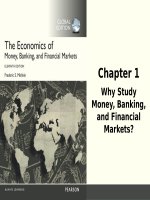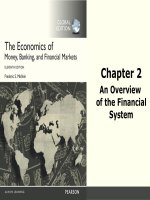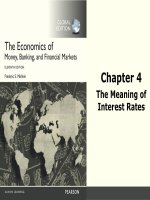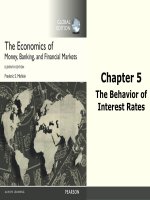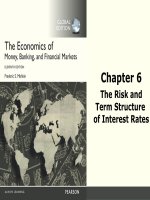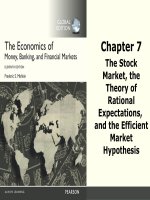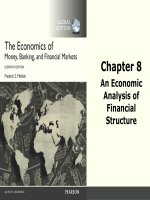The economics of money, banking, and financial institutions (11th edition) by f s mishkin ch23 aggregate demand and supply analysis
Bạn đang xem bản rút gọn của tài liệu. Xem và tải ngay bản đầy đủ của tài liệu tại đây (2.75 MB, 48 trang )
Chapter 23
Aggregate
Demand and
Supply Analysis
20-1
23-1
© 2016 Pearson Education Ltd. All rights reserved.
Preview
• This chapter develops the aggregate
demand-aggregate supply framework, which
will allow for an examination of the effects of
monetary policy on output and prices.
20-2
23-2
© 2016 Pearson Education Ltd. All rights reserved.
Learning Objectives
• Summarize and illustrate the aggregate
demand curve and the factors that shift it.
• Illustrate and interpret the short-run and
long-run aggregate supply curves.
• Illustrate and interpret shifts in the short-run
and long-run aggregate supply curves.
• Illustrate and interpret the short-run and
long-run equilibria, and the role of the selfcorrecting mechanism.
20-3
23-3
© 2016 Pearson Education Ltd. All rights reserved.
Learning Objectives
• Illustrate and interpret the short-run an longrun effects of a shock to aggregate demand.
• Illustrate and interpret the short-run and
long-run effects of temporary and
permanent supply shocks.
• Explain business cycle fluctuations in major
economies during the 2007–2009 financial
crisis.
20-4
23-4
© 2016 Pearson Education Ltd. All rights reserved.
Aggregate Demand
• Aggregate demand is made up of four
component parts:
– consumption expenditure: the total demand for consumer
goods and services
– planned investment spending: the total planned
spending by business firms on new machines, factories, and
other capital goods, plus planned spending on new homes
– government purchases: spending by all levels of
government (federal, state, and local) on goods and services
– net exports: the net foreign spending on domestic goods
and services
20-5
23-5
© 2016 Pearson Education Ltd. All rights reserved.
Aggregate Demand
Y ad C I G NX
The aggregate demand curve is downward sloping because
P � M / P
P� M /P
20-6
23-6
i
and
i
© 2016 Pearson Education Ltd. All rights reserved.
E
Y ad
I
NX
Y ad
Aggregate Demand
• The fact that the aggregate demand curve is
downward sloping can also be derived from
the quantity theory of money analysis.
• If velocity stays constant, a constant money
supply implies constant nominal aggregate
spending, and a decrease in the price level
is matched with an increase in aggregate
demand.
20-7
23-7
© 2016 Pearson Education Ltd. All rights reserved.
Figure 1 Leftward Shift in the
Aggregate Demand Curve
Inflation
Rate, π
r �, G �, T �, NX �, C �, I �, f �
decreases aggregate demand
and shifts the AD curve to the
left
AD2
AD1
Aggregate Output, Y
20-8
23-8
© 2016 Pearson Education Ltd. All rights reserved.
Figure 2 Rightward Shift in the
Aggregate Demand Curve
Inflation
Rate, π
r �,G �, T �, NX �, C �, I �, f �
Increases aggregate
demand and shifts the AD
curve to the right
AD1
AD2
Affregate Output, Y
20-9
23-9
© 2016 Pearson Education Ltd. All rights reserved.
Factors that Shift the Aggregate
Demand Curve
• An increase in the money supply
shifts AD to the right: holding velocity
constant, an increase in the money supply
increases the quantity of aggregate demand
at each price level.
• An increase in spending from any of
the components C, I, G, NX, will also shift AD
to the right.
20-10
23-10
© 2016 Pearson Education Ltd. All rights reserved.
Summary Table 1
Factors That
Shift the
Aggregate
Demand Curve
20-11
23-11
© 2016 Pearson Education Ltd. All rights reserved.
Aggregate Supply
• Long-run aggregate supply curve:
– Determined by amount of capital and labor and
the available technology
– Vertical at the natural rate of output generated
by the natural rate of unemployment
• Short-run aggregate supply curve:
– Wages and prices are sticky
– Generates an upward sloping SRAS as firms
attempt to take advantage of short-run
profitability when price level rises
20-12
23-12
© 2016 Pearson Education Ltd. All rights reserved.
Figure 3 Long- and Short-Run
Aggregate Supply Curves
20-13
23-13
© 2016 Pearson Education Ltd. All rights reserved.
Shifts in Aggregate Supply Curves
• Shifts in the long run aggregate supply
curve
– The long-run aggregate supply curve shifts to the
right from when there is:
1. An increase
economy
2. An increase
economy
3. An increase
4. A decline in
in the total amount of capital in the
in the total amount of labor supplied in the
in the available technology, or
the natural rate of unemployment
– An opposite movement in these variables shifts
the LRAS curve to the left.
20-14
23-14
© 2016 Pearson Education Ltd. All rights reserved.
Figure 4 Shift in the Long-Run
Aggregate Supply Curve
20-15
23-15
© 2016 Pearson Education Ltd. All rights reserved.
Shifts in the Short-Run Aggregate
Supply Curve
• There are three factors that can shift the
short-run aggregate supply curve:
1. Expected inflation
2. Price shocks
3. A persistent output gap
20-16
23-16
© 2016 Pearson Education Ltd. All rights reserved.
Summary Table 2 Factors That Shift
the Short-Run Aggregate Supply
Curve
20-17
23-17
© 2016 Pearson Education Ltd. All rights reserved.
Figure 5 Shift in the Short-Run Aggregate
Supply Curve from Changes in Expected
Inflation and Price Shocks
20-18
23-18
© 2016 Pearson Education Ltd. All rights reserved.
Figure 6 Shift in the Short-Run Aggregate
Supply Curve from a Persistent Positive
Output Gap
20-19
23-19
© 2016 Pearson Education Ltd. All rights reserved.
Equilibrium in Aggregate Demand
and Supply Analysis
• We can now put the aggregate demand and
supply curves together to describe general
equilibrium in the economy, when all
markets are simultaneously in equilibrium at
the point where the quantity of aggregate
output demanded equals the quantity of
aggregate output supplied.
20-20
23-20
© 2016 Pearson Education Ltd. All rights reserved.
Short-Run Equilibrium
• Figure 7 illustrates a short-run equilibrium in
which the quantity of aggregate output
demanded equals the quantity of output
supplied.
• In Figure 8, the short-run aggregate demand
curve AD and the short-run aggregate
supply curve AS intersect at point E with an
equilibrium level of aggregate output at
*
and an equilibrium
Y
inflation rate at .
*
20-21
23-21
© 2016 Pearson Education Ltd. All rights reserved.
Figure 7 Short-Run Equilibrium
20-22
23-22
© 2016 Pearson Education Ltd. All rights reserved.
Figure 8 Adjustment to Long-Run Equilibrium
in Aggregate Supply and Demand Analysis
20-23
23-23
© 2016 Pearson Education Ltd. All rights reserved.
Self-Correcting Mechanism
• Regardless of where output is initially,
it returns eventually to the natural rate.
• Slow:
– Wages are inflexible, particularly downward
– Need for active government policy
• Rapid:
– Wages and prices are flexible
– Less need for government intervention
20-24
23-24
© 2016 Pearson Education Ltd. All rights reserved.
Changes in Equilibrium: Aggregate
Demand Shocks
• With an understanding of the distinction
between the short-run and long-run
equilibria, you are now ready to analyze
what happens when there are demand
shocks, shocks that cause the aggregate
demand curve to shift.
20-25
23-25
© 2016 Pearson Education Ltd. All rights reserved.
